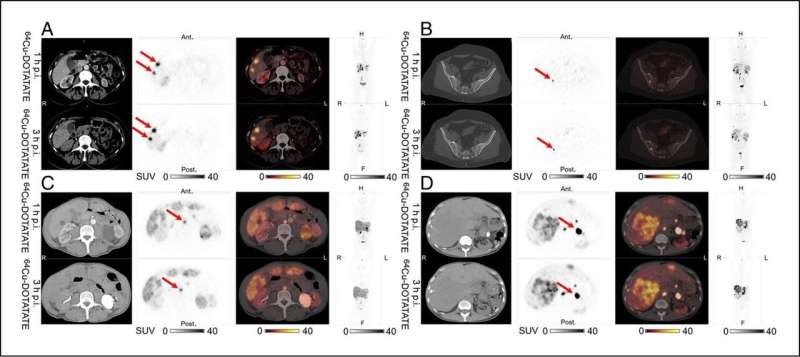
The imaging time window of 64Cu-DOTATATE positron emission tomography/computed tomography (PET/CT) for patients with neuroendocrine neoplasms can be expanded from one hour to three hours post-injection, according to new research published in the January issue of the Journal of Nuclear Medicine. In a head-to-head comparison of scans performed at the two time intervals, there were no significant differences in the number of lesions detected, and tumor-to-normal tissue ratios remained high in all key organs.
Previous research has demonstrated that 64Cu-DOTATATE PET imaging at one hour post-injection provides excellent lesion detection in patients with neuroendocrine neoplasms. “Given the long half-life and excellent image resolution of 64Cu-DOTATATE, we sought to investigate if the imaging time window for 64Cu-DOTATATE PET could be expanded from one hour to up to three hours without a loss in the ability to detect lesions,” said Andreas Kjaer, MD, Ph.D., DMSc, professor at University of Copenhagen and chief physician at Rigshospitalet, the National University Hospital of Denmark, both in Copenhagen, Denmark.
In the prospective study, 35 patients with neuroendocrine neoplasms received 64Cu-DOTATATE whole-body PET imaging at both one hour post-injection and three hours post-injection. The number of lesions on the scans were counted and grouped according to organs or regions and were then compared. Uptake of 64Cu-DOTATATE in lesions and normal tissues was measured, and tumor-to-normal tissue ratios were calculated.
A total of 882 concordant lesions (visible on both the one-hour and three-hour post-injection 64Cu-DOTATATE PET) were found. Five discordant lesions, which were found on one of the PET scans but not the other, were noted; however, only four were considered true based on further imaging. Throughout the one to three hour post-injection imaging window, the tumor-to-normal tissue ratios were high in all key organs, including the liver, intestines, pancreas and bone.
“The high agreement in the number of lesions detected on both the one-hour and three-hour post-injection 64Cu-DOTATATE PET supports the rationale of expanding the imaging time window,” stated Kjaer. “Since 64Cu-DOTATATE has a shelf-life of 24 hours, which is much longer than other PET imaging options, it offers greater convenience and flexibility for routine imaging of patients with neuroendocrine neoplasms. We expect to see more 64Cu-labeled PET tracers for routine use in the future.”
Source: Read Full Article
